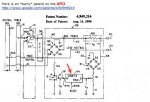K8MHZ
Senior Member
- Occupation
- Electrician
Rather than skew off a GFCI thread, I though I would post some info about how the cursed AFCI's actually work.
I even found a video from Eaton where they used real sparks to demonstrate the breakers. You may want to fast forward to about the 5 minute mark if you want to skip the basic electricity lesson.
http://www.youtube.com/watch?v=ihforRdL-TU
The crux of the biscuit is that an arc created by a fault will have a current symmetry that differs from an arc created by an intentional load.
http://www.pfeiffereng.com/The Arc Fault Circuit Interrupter.pdf
The above link also has a block diagram of the workings of an AFCI.
Here is a link to Square D's documents about AFCI's
http://products.schneider-electric....bination-arcfault-circuit-interrupters/#tab=2
Here are some basics.
Most household breakers have a 200 amp short circuit rating, meaning for a very short period of time, they can carry 200 amps and stay closed. This is actually needed to assure that devices with large amounts of in rush currents don't trip the breaker.
The average amount of short circuit current available at the average receptacle is 75 A. This means a direct short at a receptacle will take part of the time curve to trip the breaker.
One feature of an AFCI is that they target a current below 75 A for an instantaneous trip.
The 'signature' of an arc is what it's pattern would look like on a scope. It looks like arcs coming from faults are very asynchronous and have characteristics that arcs from say, the brushes of a motor have. The signature of an intentional load, no matter if a bit messy or not, will have a repeating pattern from start to finish. Fault arcs will have more of a random pattern and usually will exhibit decay before they burn themselves out.
Now, the 75 amp and below limit is for a hot to neutral fault. The amount of current that in a series (broken hot or neutral) is already limited by the load, so the amount can be below 15 or 20 amps, for instance, and still make a dangerous spark. A combo AFCI is one that will shut down on both a series (current limited by load) arc and a parallel one (hot to neutral). It doesn't mean it has a GFCI built in.
I even found a video from Eaton where they used real sparks to demonstrate the breakers. You may want to fast forward to about the 5 minute mark if you want to skip the basic electricity lesson.
http://www.youtube.com/watch?v=ihforRdL-TU
The crux of the biscuit is that an arc created by a fault will have a current symmetry that differs from an arc created by an intentional load.
http://www.pfeiffereng.com/The Arc Fault Circuit Interrupter.pdf
The above link also has a block diagram of the workings of an AFCI.
Here is a link to Square D's documents about AFCI's
http://products.schneider-electric....bination-arcfault-circuit-interrupters/#tab=2
Here are some basics.
Most household breakers have a 200 amp short circuit rating, meaning for a very short period of time, they can carry 200 amps and stay closed. This is actually needed to assure that devices with large amounts of in rush currents don't trip the breaker.
The average amount of short circuit current available at the average receptacle is 75 A. This means a direct short at a receptacle will take part of the time curve to trip the breaker.
One feature of an AFCI is that they target a current below 75 A for an instantaneous trip.
The 'signature' of an arc is what it's pattern would look like on a scope. It looks like arcs coming from faults are very asynchronous and have characteristics that arcs from say, the brushes of a motor have. The signature of an intentional load, no matter if a bit messy or not, will have a repeating pattern from start to finish. Fault arcs will have more of a random pattern and usually will exhibit decay before they burn themselves out.
Now, the 75 amp and below limit is for a hot to neutral fault. The amount of current that in a series (broken hot or neutral) is already limited by the load, so the amount can be below 15 or 20 amps, for instance, and still make a dangerous spark. A combo AFCI is one that will shut down on both a series (current limited by load) arc and a parallel one (hot to neutral). It doesn't mean it has a GFCI built in.



